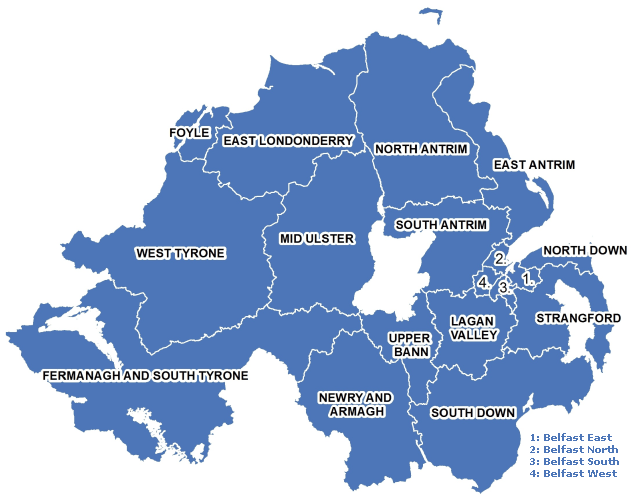The May 2016 election was the last at which 108 Members would be returned to the Assembly. At the next Assembly election there will be a reduction in the number of MLAs returned. The Fresh Start Agreement of November 2015 contained a commitment to reduce the number of MLAs from 108 to 90 and this commitment will be implemented through the Assembly Members (Reduction of Numbers) Bill 2016, which reduces from six to five the number of MLAs returned per constituency. These changes will take effect at the 2021 election or earlier if an extraordinary Assembly election is called. But the constituencies used for Assembly elections are defined in the Northern Ireland Act 1998 as those used for UK parliamentary elections. Potential changes to the number of these constituencies would impact, therefore, on the number of MLAs at the time of the next scheduled Assembly election in 2021.

Boundary Review 2018
In 2011 legislation was passed to reduce the number of MPs from 650 to 600 and it appeared that Northern Ireland would lose two constituencies in time for the 2015 UK Parliamentary election as a result of boundary changes needed to implement the reduction. However, the 2013 review of constituency boundaries was halted because of disagreements within the previous coalition Government over constitutional reform.
In February 2016, with a new Conservative government in power, a fresh boundary review was announced. The Boundary Commission for Northern Ireland, on initiation of the latest review, stated that the number of parliamentary constituencies here would decrease from 18 to 17 at the next Westminster elections, expected in 2020. Should other factors remain unchanged, the impact of this change will mean the number of MLAs would, following implementation of the boundary changes, drop not to 90 but to 85 at the next scheduled Assembly election.
In Scotland the statutory link between the Scottish Parliamentary constituencies and those for the House of Commons was removed in legislation passed in 2004. A similar decoupling has also taken place in Wales, where constituency boundaries for the National Assembly differ from those for Westminster elections.
Potential impact
When the Assembly and Executive Review Committee looked at this issue, it received submissions from stakeholders that raised the issue of how a reduction in MLAs might impact on inclusiveness and political representation. For example, a move from six to five member constituencies could, it was argued, make it more difficult for smaller parties and independents to obtain seats.
Furthermore, the potential impact on female representation was raised, with concerns expressed that a reduction could make it more difficult to increase the number of female MLAs. Should further consideration be given to how the proposal to move from six to five members per constituency could impact on political representation in terms of smaller parties, independents and women?
An opposing argument could be made that separate Assembly constituencies would mean three sets of electoral boundaries – local government, Assembly and Westminster. Could this lead to voter confusion? It shouldn’t, as voters in Northern Ireland have been used to elections using the single transferable vote system and multiple elections on the same day.
Another option would be to bring forward the 2021 Assembly election and combine it with the 2020 Westminster election. This would mean that the provisions of the boundary review and the 2016 Assembly Act could come into force at the same time. But it would go against what appears to be the desirability of trying to keep devolved elections separate from Westminster elections.
When this issue was considered by the Assembly & Executive Review Committee, there was no consensus on the way forward. However, now that a reduction in MLAs will happen at the next Assembly election, there may be a renewed interest in the case for decoupling, as doing so would mean that any future changes to Westminster boundaries would not automatically impact on the number of Assembly members.

